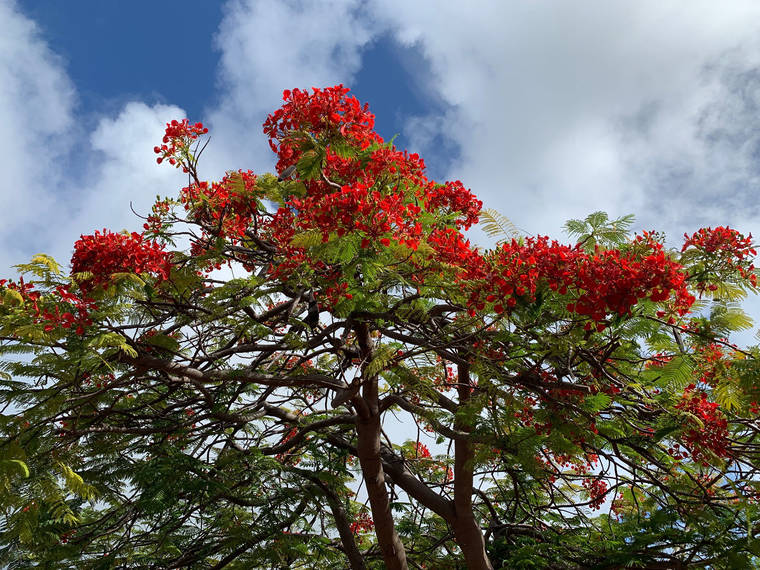As the days get warmer and the sun is strong, it is a great time to enjoy Hawaii’s flowering trees such as the royal poinciana, tabebuia, plumeria, cassia shower, narra and many more.
Speaking of narra, this beautiful yellow flowering tree from tropical Asia is rare but should be planted more. There is a beautiful specimen at Hale Anuhea in South Kona.
There was a time when forests covered much of the lands that are now grass, savannah and desert. Early Polynesians brought with them pigs, rats and jungle fowl that are the ancestors of modern day chickens. The impact on our endemic loulu palm forests was devastating, but with the introduction of grazing animals in the late 18th century, our forests really began to shrink.
The vast koa forests once common are now mere remnants of their past glory. Now the threat of rapid ohia death might further decimate our forests.
Loss of forests affects the climate and exacerbates global warming. Forests are the lungs of the planet, supplying oxygen as they reduce carbon dioxide and sequester carbon.
Luckily, some folks know the value of forests and windbreaks.
Our progressive ranchers are planting some koa and valuable timber trees at higher elevations. Then there are groups such as the Outdoor Circles, plant societies, youth groups and community clubs that are doing what they can to reforest.
Well planned areas such as the resorts of West Hawaii are literally being transformed into tropical oases through urban forestation. These are examples we can follow.
So how can we, as individuals, help beautify and make our environments more enjoyable?
Nonprofit groups such as the Nature Conservancy and the recently formed Moku o Keawe are giving landowners the opportunity to protect our forests. For more information on how Moku o Keawe can help, contact Janet Britt at 769-4343.
You don’t have to be a big landowner to add to the forests of our island. Even folks with small lots can help. By planting trees in our little pieces of paradise, we can actually change the microclimate and make our communities several degrees cooler in the summer.
If you place your trees just right, you can even create a garden climate that is milder during cool, windy periods. It’s really interesting when you expand these basic principles.
What happens when everyone in your neighborhood or community plants shade trees?
You can actually change the climate over fairly large areas. Foresters have research data that show reforestation can increase local rainfall and modify temperature extremes.
Now let’s look at the tree planting from another angle.
Visitors bring millions of dollars to Hawaii each year. Our sunny winter skies are a big attraction. It used to be that our beaches and tropical woodlands were part of that appeal. Now with urban sprawl and rising ocean levels on some of our best beaches, our main salvation from endless asphalt alleys is abundant landscaping and protection of green open spaces.
Planting trees to give shade and beautify our communities isn’t the complete answer, but it can help.
Shopping is miserable when streets are barren and parking lots are hot and uncomfortable. Hotels, restaurants and gas stations that are attractively landscaped with shade trees, shrubs and grass attract customers. Even grocery and department stores are finding landscaping pays off.
In tree planting activities, remember proper planting is important, as well as a knowledge of the tree’s requirements. Be sure to choose trees that the space in which they must grow.
The rapid development of West Hawaii must include more efforts to landscape. Just imagine our new roads and highways shaded by spectacular trees such as the royal poinciana, or flamboyant.
This tree from Madagascar was almost extinct in its native habitat, but thanks to its beauty, it has been spread to tropical regions around the world. The extremely rare yellow flowered form is also found in Hawaii.
Rainbow showers developed in Hawaii are drought tolerant like the poinciana and well adapted to West Hawaii conditions.
Our state tree, the kukui, brought to Hawaii by the first Polynesians, should also be used more. And let’s not forget the many endemic species of pritchardia or loulu. We need to use them in the landscape to assure their survival.
In some new developments, underground utilities are installed. This allows freedom from wires and poles. In such well-planned tracts, street side shade trees can be planted to minimize the negative impact of asphalt and concrete.
There are many good books to help in choosing the right trees to plant. Sunset’s “New Western Garden Book” covers all the climate zones we have here, even if one lives at sea level or at 6,000-foot elevation.
In Hawaii, we have a wide variety of plants for beauty and as a food source for humans and our wildlife. By keeping abundant vegetation as an integral part of our human communities, we find a constant healthy connection with our natural world.
For further assistance in tree selection and maintenance, call the Master Gardener Helpline in Kona at 322-4893 or 981-5199 in Hilo.

